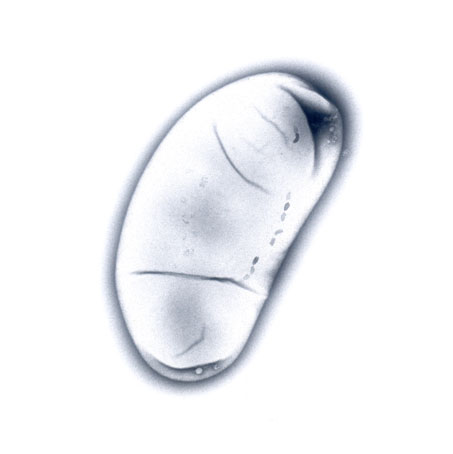Desulfovibrio magneticus RS-1T (= NBRC 104933T)
Magnetotactic bacteria make magnetosomes (small membrane-encapsulated magnetites with 30-50nm diameter) in the cells, and swim along the external magnetic field. They are found in both fresh water and seawater sediments, and have various cell shapes such as vibrio, cocci, and spillum. On the other hand, sulfate-reducing bacteria such as those of the genus Desulfovibrio are known to be gram-negative, obligately anaerobic bacteria. They produce hydrogen sulfide by the reduction of sulfate and other oxidized sulfur compounds along with the oxidation of organic compounds, thus playing an important role in the sulfur cycle.
Desulfovibrio magneticus RS-1 is so far the only magnetotactic bacterium isolated from the group of sulfate-reducing bacteria belonging to delta-proteobacteria, while most of the other characterized magnetotactic bacteria belong to alpha-proteobacteria. It was isolated from the sediment of a waterway near the Kameno river in the Wakayama prefecture.
Genome analysis revealed that the genome of Desulfovibrio magneticus RS-1 consists of a circular chromsome (5,248,049bp) and two circular plasmids (pDMC1: 58,704bp, pDMC2: 8,867bp). Detailed comparison with other sequenced genomes of magnetotactic bacteria, which all belong to alpha-proteobacteria, will elucidate the molecular and evolutionary mechanisms of magnetosome synthesis. The genomic data may also facilitate the utilization of this bacterium in various fields of biotechnology such as the production of industrially useful magnetic materials and the exploitation of the characteristics of sulfate-reducing bacteria in bioremediation.

Courtesy of
Dr. Matsunaga in Tokyo University of Agriculture and Technology
References:
- [1] Magnetite formation by a sulphate-reducing bacterium
- Sakaguchi, T., Burgess, J.G., Matsunaga, T. (1993)
Nature. 365(47-49). - [2] Cadmium recovery by a sulfate-reducing magnetotactic bacterium, Desulfovibrio magneticus RS-1, using magnetic separation.
- Arakaki A, Takeyama H, Tanaka T, Matsunaga T. (2002)
Appl Biochem Biotechnol. 2002 Spring;98-100:833-40. [PMID:12018305] - [3] Desulfovibrio magneticus sp. nov., a novel sulfate-reducing bacterium that produces intracellular single-domain-sized magnetite particles.
- Sakaguchi T, Arakaki A, Matsunaga T. (2002)
Int J Syst Evol Microbiol. 2002 Jan;52(Pt 1):215-21. [PMID:11837306] - [4] Formation of magnetite by bacteria and its application.
- Arakaki A, Nakazawa H, Nemoto M, Mori T, Matsunaga T. (2008)
J R Soc Interface. 2008 Sep 6;5(26):977-99. [PMID:18559314] - [5] Proteomic analysis of irregular, bullet-shaped magnetosomes in the sulphate-reducing magnetotactic bacterium Desulfovibrio magneticus RS-1.
- Matsunaga T, Nemoto M, Arakaki A, Tanaka M. (2009)
Proteomics. 2009 Jul 3;9(12):3341-3352. [PMID:19579222] - [6] Whole genome sequence of Desulfovibrio magneticus strain RS-1 revealed common gene clusters in magnetotactic bacteria.
- Nakazawa H., Arakaki A., Narita-Yamada S., Yashiro I., Jinno K., Aoki N., Tsuruyama, A., Okamura Y., Tanikawa S., Fujita N., Takeyama H. and Matsunaga T. (2009)
Genome Res. 2009 Oct;19(10):1801-8. [PMID:19675025] - [7] Desulfovibrio magneticus RS-1 contains an iron- and phosphorus-rich organelle distinct from its bullet-shaped magnetosomes.
- NByrne M., Ball D., Guerquin-Kern J., Rouiller I., Wu T., Downing K., Vali H., Komeili A. (2010)
Proc Natl Acad Sci. 2010 July 6;107(27):12263-8. [PMID:20566879]
| chromosome | pDMC1 | pDMC1 | TOTAL | |
|---|---|---|---|---|
| Genomic size (bps) | 5,248,049 | 58,704 | 8,867 | 5,315,620 |
| The number of ORFs | 4,630 | 65 | 10 | 4,705 |
| GC content (%) | 62.77 | 58.03 | 37.17 | 62.67 |
| Genome Database | DOGAN | |||
| NBRC* No. : | 104933 | |||
- *:
- NBRC is the acronym for "the NITE Biological Resource Center".
The URL of NBRC is http://www.nbrc.nite.go.jp/e/index.html.
- Distribution of Our Microbial Genomic DNAs
- At the Biological Resource Center of the National Institute of Technology and Evaluation (NITE Biological Resource Center, an Incorporated Administrative Agency), we have been distributing the microbial genomic DNA.
Contact us
- Industrial Innovation Division, Biological Resource Center, National Institute of Technology and Evaluation
-
Address:2-49-10 Nishihara, Shibuya-ku, Tokyo 1510066, Japan MAP
Contact Form


